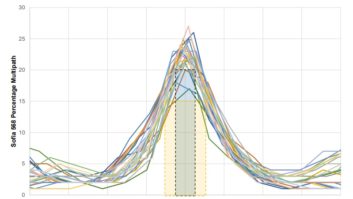The FCC has more technical feedback to sift through on how a system that allows FM radio stations to geo-target signals works in the real world.
Field testing of the ZoneCasting system from GeoBroadcast Solutions shows the transition areas between zones “can be designed and programmed to take up a miniscule portion of a station’s service area and be infrequent, transitory, unobjectionable, and in most cases unobservable to the listener,” according to Covington & Burling LLP.
The report details the performance and end-user experience from the deployment of ZoneCasting at KSJO(FM) in San Jose, Calif., during field testing conducted by Roberson and Associates. The report concludes the geo-targeting technology works with both analog and HD Radio systems and does not affect the performance of EAS system, the proponents say.
[Read: EMF Deploys MaxxCasting in Chicago]
Geo-targeting broadcast technology, according to GBS, creates local zones out of an FM and FM+HD broadcast coverage area to enable unique, targeted programming and advertising for listeners in the zone during short periods but is designed that the zones do not adversely impact the listener experience. ZoneCasting creates geo-targeted zones by using specifically located booster transmitters and appropriately designed antennas to overlay a stronger, geographically localized signal in the targeted region.
GBS says geo-targeted programming and advertising in a zone would occur for only short periods, typically about three minutes per hour, in order to place zone targeted advertising, according to the report.
The new report’s findings summarize tests results from 31 hours of audio recorded from over 60 drives at various speeds over multiple weeks this summer. KSJO operates two transmitters, according to the report, the main transmitter covering the region from an elevated site south of San Jose and a low-power booster that covers the northern section of the station’s listening area.
The radio station’s two coverage areas are separated by a largely unpopulated mountain range, according to the report, with “testing conducted in the zone transition area.”
The field test found the FM signal was stable inside the transition zones but some limited audio quality issues were identified during zone transition.
“Our data and analysis indicate that a properly designed zone transition can deliver a highly compact region — a tiny portion of KSJO’s service area — over which any degraded analog FM audio will be experienced,” according to the report’s authors.
The measured results in the report indicate a zone transition length of 50.2 meters, which Roberson and Associates deemed as “insignificant” when compared to the total length of roads within the zone.
Data collectors acknowledge there were differences when listening to zone transitions in FM and HD1 mode during testing. “The overall zone transition listening experience for HD1 was very good, with almost instantaneous transitions without noticeable audio degradation,” they wrote.
[Read: Geo-Targeting Proposal Hits Headwinds]
Meanwhile, the HD2 transition zone experience revealed short audio dropouts, which was expected due to the current use of unsynchronized HD exporters, according to the analysis. They said efforts are underway to develop means to synchronize HD exporters that should reduce the duration of HD2 signal loss.
The report also found the zone transitions caused no display variations of metadata on car receivers. And EAS operation was successful within the ZoneCasting test location after operations of the KSJO EAS geo-targeting override was tried in two different locations. “The simultaneous reception of identical EAS tones at these two locations confirms geo-targeted broadcasting will not affect performance of the EAS system,” the report from Roberson and Associates states.
The geo-targeting report concludes: “Having made numerous careful measurements and having assessed the results of these measurements in considerable depth, it is our conclusion that the geo-targeted broadcast system provides both a practical and highly beneficial capability. It is therefore our studied opinion that there is no technical reason that the geo-position zone broadcasting petition before the FCC should not be approved.”
The FCC adopted a Notice of Proposed Rulemaking in Nov. 2020 to review the GBS technology and found opponents of the geo-targeted proposal expressed fear that the new technology could create interference and cause listeners to tune out. Broadcast groups, including Cumulus Media, Entercom Communications, and iHeartMedia, have said at the time more vetting of the technology was needed. The National Association of Broadcasters also told the FCC the GBS proposal could undermine radio’s business model by depressing advertising rates as advertisers replace market-wide ads with less expensive ones on the zoned boosters.
The geo-targeted technology has been in development by GBS since 2011 and has been through previous field tests.









